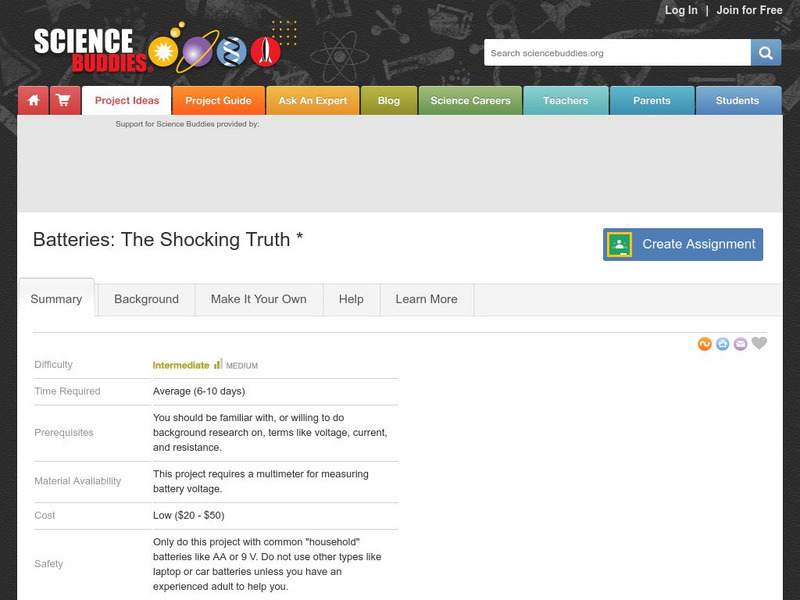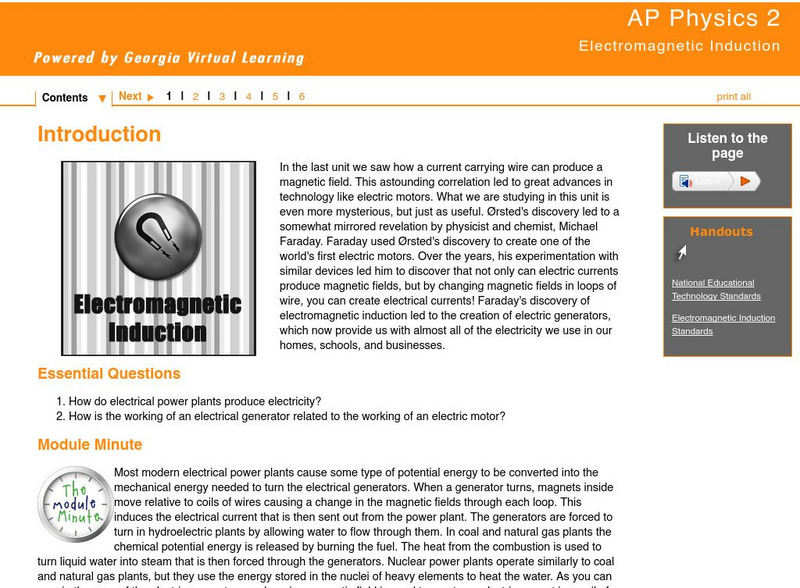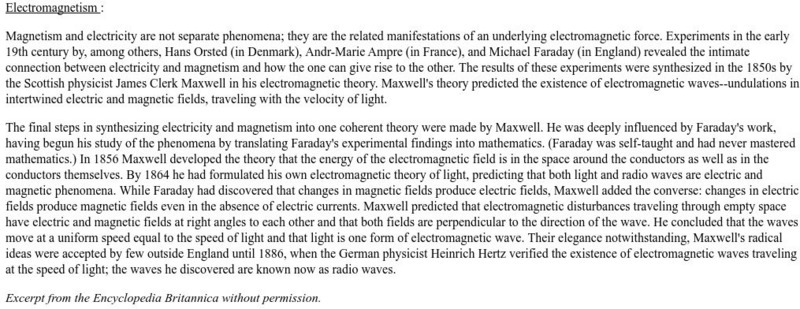Texas Education Agency
Texas Gateway: Electrifying Energy
This tutorial reviews over electrical energy.
Creative Science Centre
Creative Science Centre: Perhaps the Simplest Homemade Generator in the World
This very simple, but effective generator shows in a wonderfully engaging way the fundamentals of electricity generation. The generator is made from a coil of wire wound around the outside of a plastic 35mm-film can. The two coil ends...
University of Colorado
University of Colorado: Ph Et Interactive Simulations: Faraday's Law
Investigate Faraday's law and how a changing magnetic flux can produce a flow of electricity!
Georgia State University
Georgia State University: Hyper Physics: Potential Energy
This site from Georgia State University Physics Department defines and explains the concept of potential energy. Using equations and graphics to illustrate the idea, it discusses the many types of potential energy (gravitational,...
PBS
Pbs Learning Media: Solar House
In this What's Up in the Environment? video segment, an electrical engineer in Virginia and his 13-year-old son explain how they produce electricity in their home. [3:58]
Princeton University
Princeton University: Joseph Henry
A really fine and complete biography, quite lengthy. Some emphasis placed on his time at Princeton. A great deal of detail can be found here. Link here to the Joseph Henry House.
Oak Ridge National Laboratory
Ornl: Teacher's Guide Superconductivity for High School Students
This site from the Human Genome Project provides a large collection of facts and information, demonstrations, experiments and project ideas. Written for teachers but easily adaptable for any type of student work. A good site to check out...
Science Buddies
Science Buddies: Batteries: The Shocking Truth
Here you can find what you need to scientifically assess battery performance. In this exercise (that should take about one week) learn how batteries work, how they wear out and most importantly, how to make valid measurements to assess...
Science Buddies
Science Buddies: A Battery That Makes Cents
Batteries are expensive to purchase in a store, but you can make one your self for exactly 24 cents. In this experiment, you will make your own voltaic pile using pennies and nickels and determine how many coins in a pile will make the...
Nobel Media AB
The Nobel Prize: The Nobel Prize in Chemistry 1908
At this site read about Ernest Rutherford (1871-1937 CE), the scientist who was awarded the Nobel Prize in Chemistry, "for his investigations into the disintegration of the elements, and the chemistry of radioactive substances." This...
Georgia Department of Education
Ga Virtual Learning: Ap Physics 2: Electromagnetic Induction
Through labs, readings, videos, and discussions, students learn about the concepts of Electromagnetic Induction.
Science Buddies
Science Buddies: Shaking Up Some Energy
Shake N' Light flashlights have been advertised on televisions across the nation in the recent year. But many do not understand just how they get energy to light up the bulb without using batteries. Do this experiment to make your own...
World Health Organization
World Health Organization: International Emf Project
The World Health Organization probes into the feared associations between electromagnetic fields (EMFs) and cancer. Check out "What is EMF?" for detailed summaries on what electromagnetic fields are and the possible health effects, or...
Georgia State University
Georgia State University: Hyper Physics: Voltage
Electrical currents and voltage are defined and illustrated.
University of Minnesota
University of Minnesota: Ships: Science & Religion of Michael Faraday
Here's a whole different look at Faraday. His religion, Sandemanian, greatly influenced both his life and his science. This article looks deeply at that aspect of his life.
Science Buddies
Science Buddies: Build Your Own Windmill Generator
Build your own windmill and see how the wind can be converted into energy to produce electricity. This science fair project should help you understand the use of wind as a source of alternative energy. The Science Buddies project ideas...
Science Bob Pflugfelder
Science Bob: Build an Electromagnet!
This site presents a procedure for creating your own electromagnet using an iron nail, some wire, and a battery. The site illustrates a connection between electricity and magnetism.
University of Oregon
University of Oregon: Electromagnetism
A solid summary from the University of Oregon of the work of James Maxwell Clerk, Michael Faraday, and others in the field of electric and magnetic phenomena. This is a fine essay.
Smithsonian Institution
Lemelson Center: Spark!lab: Build a Speaker
Learn how to build your very own speaker with items usually found around the house. Follow step-by-step instructions and discover how to use your speaker to listen to the radio.
ClassFlow
Class Flow: Turning on the Lights
[Free Registration/Login Required] In this lesson students learn the parts of a circuit, build series and parallel circuits, learn about insulators and conductors, and more in this interactive multimedia flipchart.
Florida State University
Florida State University: Lightning, a Natural Capacitor
Text and animated graphic show how lightning is an example of a natural capacitor.
Physics Classroom
The Physics Classroom: Put the Charge in the Goal
Students face a game-like challenge to use electrostatic forces to move a charged puck into a goal. By placing charges on the rink, a charged puck can be attracted and repelled around obstacles and into a goal.
CK-12 Foundation
Ck 12: Physical Science: Electromagnetic Waves
[Free Registration/Login may be required to access all resource tools.] Provides the definition of an electromagnetic wave, electromagnetic radiation, and electric and magnetic fields. Also discusses how electromagnetic waves begin,...
Curated OER
Ultra Simple Electric Generator
All the components are here for you to build an electric generator. Parts list, construction, testing, how it works, feel the electrons, and more.














